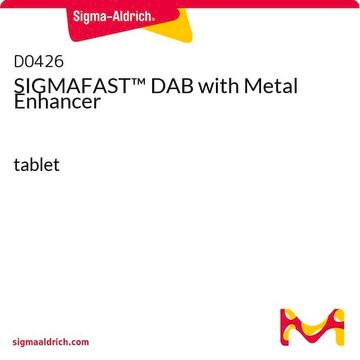D4418
3,3′-Diaminobenzidine
SIGMAFAST™, chromogenic, tablet
Synonym(s):
DAB, DAB tablets, Immunohistology substrate
About This Item
Recommended Products
product name
SIGMAFAST™ 3,3′-Diaminobenzidine tablets, tablet, To prepare 15 mL
Quality Level
form
tablet
solubility
water: 1 tablet/5 mL
storage temp.
−20°C
SMILES string
Nc1ccc(cc1N)-c2ccc(N)c(N)c2
InChI
1S/C12H14N4/c13-9-3-1-7(5-11(9)15)8-2-4-10(14)12(16)6-8/h1-6H,13-16H2
InChI key
HSTOKWSFWGCZMH-UHFFFAOYSA-N
Looking for similar products? Visit Product Comparison Guide
Related Categories
Application
Reconstitution
Legal Information
Signal Word
Danger
Hazard Statements
Precautionary Statements
Hazard Classifications
Acute Tox. 4 Oral - Carc. 1B - Eye Dam. 1 - Muta. 2 - Skin Irrit. 2 - STOT SE 3
Target Organs
Respiratory system
Storage Class Code
6.1C - Combustible acute toxic Cat.3 / toxic compounds or compounds which causing chronic effects
Flash Point(F)
Not applicable
Flash Point(C)
Not applicable
Certificates of Analysis (COA)
Search for Certificates of Analysis (COA) by entering the products Lot/Batch Number. Lot and Batch Numbers can be found on a product’s label following the words ‘Lot’ or ‘Batch’.
Already Own This Product?
Find documentation for the products that you have recently purchased in the Document Library.
Customers Also Viewed
Articles
NBT-BCIP substrate system aids in western blotting and immunohistological staining, producing a blue-purple insoluble end product.
Protocols
Use this protocol to for the entire immunohistochemistry (IHC) procedure through staining and visualization of specific antigens in paraffin-embedded tissue sections.
Protocol for sample preparation for cell lysis and efficient protein extraction from cultured tissues and cells for subsequent Western blotting.
Our team of scientists has experience in all areas of research including Life Science, Material Science, Chemical Synthesis, Chromatography, Analytical and many others.
Contact Technical Service











